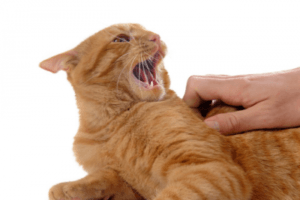From time to time, friends give me books about cats. They must think I like the critters, or something. Today I will review one of those books, to help you answer the question, “What is the cat saying?”
The book I’m reviewing is called Cat Talk, by Carole C. Wilbourn, cat therapist. In it, she will give examples of a variety of cat situations, and then explains through these what your cat is trying to tell you.
Carole explains that she tries to help people understand their cat’s daily needs, so the person will relate in a way that promotes emotional and physical health for them both.
Carole got involved in this career because she wanted to help cats. She has learned from working with cats that have already developed emotional problems, that these often trigger medical ones. Carole says she thinks it important to treat the total cat.
When Carole met her husband, Paul Rowan, the associate in her vet’s office, they soon developed a passion for each other as well as for cats. Then, in 1973, the two of them opened The Cat Practice in New York City’s West Village. It was the first hospital in New York City devoted solely to cats.
During the cat’s visit to the hospital, the patient got a catnip toy handmade by the staff. He also received a cheer-up card in the mail when he returned home.

Carole taught people that it is important to be relaxed and low-key with patients. Cats are very sensitive to feelings, and if the person is anxious, that will lead to the cat’s discomfort. Also, large amounts of stress can cause some kitty problems. I can think of two immediate examples of these from my old cat, adopted a year ago from a shelter.
He had alopecia (which means he pulled out his fur). The fur was completely gone from his stomach, and from a few other places as well.
Getting out of the shelter environment took care of most of the problem. The cat had been there for 7 1/2 months. The dogs at the other end of the building never shut up, and my poor timid cat spent all his time being scared.
Just moving to a very quiet environment helped him a great deal. At first, he’d wake up a night and begin compulsively pulling at his fur. I think he was dreaming. I’d pet him and talk to him quietly, until he relaxed and returned to sleep. Finally, his nightmares stopped.

Then, the next issue: I had to get his claws cut, and I was too nervous to do it. He knew it, too, because he hissed at me when I tried to cut a claw.
A friend came to my aid. She said she’d thought of being a vet; she watched several YouTube videos on cutting a cat’s nails. She said she wanted to do it herself, with no assistance from me.
She laid a blanket on my dining room table and I put the cat up there. She smoothly did the whole job, and the cat just lay there and accepted it. She was so calm and matter-of-fact that he must have just decided he might as well go along with it. Believe me, I was happy and impressed.
Carol has some advice to give you if you think you want to become a cat therapist.
- Find a sympathetic vet with whom you can establish a trustful relationship.
- Design a health-inducing and aesthetically pleasing environment for your work.
- Constantly observe, and never hide from even painful and unpopular conclusions.
- Make sure your clients understand your recommendations.
The chapters of this book are filled with stories from Carole’s experiences with her clients. She notes that a cat is a very sensitive animal. He acts on his feelings.
Try to interpret what the cat is trying to tell you through his body language — perhaps  a tail wag or a ripple of the back. You will be ahead of the game if you can decipher your cat’s body movements. You will have a much better idea of his feelings.
a tail wag or a ripple of the back. You will be ahead of the game if you can decipher your cat’s body movements. You will have a much better idea of his feelings.
There are posts about cat communication on this website. Here are a couple for you to check out. On this website, look at the categories in the right sidebar. You will find some helpful articles under the category, “Cat Communication.” For example, you might want to read https://theliteratecat.com/how-do-cats-communicate
Each chapter in the Cat Talk book is illustrated with examples from Carole’s collection of stories about her patients. She shows how certain actions or circumstances can cause an unwanted reaction from your cat, and how to solve the problem. Here is one example:
Sometimes when a cat has the choice of going outdoors, he will decide to move to another home. Jaboo, a California cat, used to live with his people, Judy and Steve and companion cat, Hathaway. Jaboo liked to roam the canyons near their home.
Then Judy and Steve found they had to spend several months in New York City. Judy left ahead of time because of business commitments. During that time, Jaboo disappeared for several days.
Steve posted a notice, and some people from clear across the canyon responded. Steve learned that the cat had visited these people before. Steve and Judy realized Jaboo would never accept the move. Then they discovered the cat had made the choice for them, as he’d already moved in with his chosen people.
You will like the many entertaining stories in the book, as well as the insights they will give you about cat behavior. Here is a list of the chapter titles:
- What Is My Cat Trying To Tell Me?
- Anticipation
- Happiness
- Sadness Or Discomfort
- Rage

Angry cat - Expressions Of Anxiety
- Choice
- Eating Patterns
- Toilet Habits
- Breathing
- Sex
- Relationship
- Cats’ Reactions To Their People’s Feelings And Body Language
If you find cats fascinating, I believe you will find this book fascinating as well. Reading Carole’s interpretations of cats’ behavior makes me want to study my own cat more closely to see what information about him I have missed.
This book was out of print for quite a while, and has now been reprinted. I found a copy for you on Amazon if you’d like to get one for yourself.
Please note that, as an Amazon associate, I may earn a small commission from your purchase. If you truly want to understand your cat, you may find some excellent clues in this book.
Cat Talk, by Carole C. Wilbourn: “What Your Cat Is Trying To Tell You”
Price: $6.18
Prime



Aww, poor kitty, I used to have one who also licked and licked at her belly until all the belly fur was gone. I’m still not sure what caused it, but the vet suspected an allergy (or perhaps a single bite) that set off a sort of a nervous tick / compulsion in the cat to remove the belly fur. A single cortisone shot helped the cat to break the habit and the cycle of biting her fur, but it was such a mystery the whole time as she had no other symptoms and lived a pretty routine, indoor-cat life. Perhaps the solution does lie in getting better at communicating with cat so the cat can tell it’s owner about what is causing the problem.
I think you are right. It is not easy to communicate with a cat, but with time and effort you can make progress. It is interesting that as soon as my cat got out of the shelter environment and into a quiet atmosphere where he felt safe and secure, he quit pulling out the fur. Occasionally he removes a little spot, I suppose when something upsets him, but for the most part he’s free of the habit — thank goodness!
This is great to see here and thank you so much for sharing this post out here. Cats are very beautiful and fascinating creatures that if we spend so much time with, we can really enjoy their company a lot. I feel that when we have special connection with our cats, it becomes a lot more better here to read a book such as this. Thank you
Yes, cats a great companions. As I live alone, I am especially thankful for my cat at present, since we’re in lockdown because of Covid-19, and the cat is great company. We do have a special connection, and I am so thankful to have him in my life.
Glad you enjoyed the post.